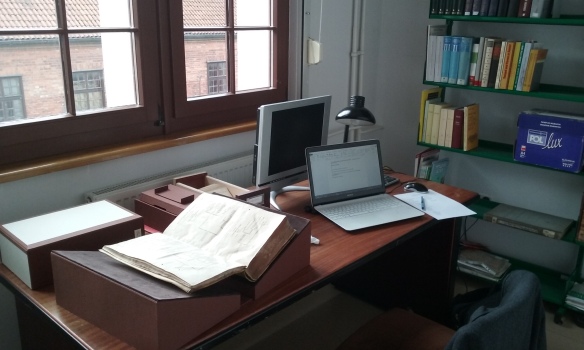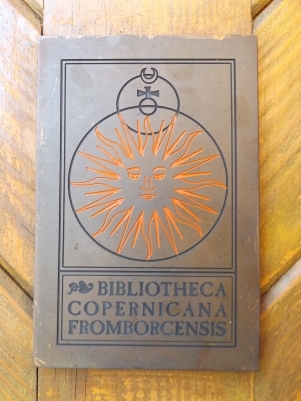It’s been quite a while since the last time I posted anything to this blog. This does not mean, however, that I quit my research, abandoned the idea, or decided to change profession. The last few months, apart from a two-week summer break dedicated solely to charging my mental and physical batteries, were actually quite intense and productive. I won’t annoy the readers with details as most of this intensity and productivity means simply sitting, reading, discussing, writing, revising and copy-editing – an endless loop known pretty well to those who are trying to make some sense out of the material they have gathered, find some new sources and publish essays on their findings in a place that would guarantee some level of readership to their work. Hopefully, some of the results of these efforts will see soon the printing press and the future posts published here will reveal some behind-the-scenes details related to other currents of my research.
Right after the summer holidays, at the turn of August and September, I rushed to Ermland, a region in the far North of Poland and visited two libraries. One of them, the Cyprian Kamil Norwid City Library in Elbląg (Elbing), was once a library of the Lutheran gymnasium, member of the famous Protestant triad consisting of educational institutions established in the 16th century in Elbląg, Toruń (Thorn) and Gdańsk (Danzig) and radiating on the southern coast of the Baltic Sea and beyond. For those of you who have visited this blog earlier, the reason for this visit will be quite predictable: I was chasing for marginalia. There are many reasons why one should expect finding some libri annotati in a library like the one in Elbląg: such historical institutions usually hold not some random old prints but volumes that were actually used in local school(s) or read by local intellectuals and then were bequeathed to or purchased by the library.

This picturesque sequence of buildings, starting with the 14th-century former Holy Spirit church, is the house of the Elbląg Library (although its special collections are located across the street, in a 19th-century building)
There is always a chance that looking through a pile of volumes will bring some new materials that will shed some light on the topics one is working on – that’s what I do in every collection I visit, apart from consulting some unique prints and manuscripts that can be consulted only in this particular place. This kind of research requires time. My list of names worth checking is constantly growing and sometimes I feel as if I was creating an alternative version of the library catalogues: the catalogues of the libraries I visit, both the ones available online and the old-fashioned card catalogues that can be consulted on-site are extremely laconic and they very rarely provide information on the ownership marks and absence/presence of annotations. The provenance catalogue is usually a mythical box hidden in the restricted area and provided only upon special request. Should I add that such thing as a catalogue dedicated explicitly of libri annotati is only an object of wishful thinking? This always end up in massive orders, semi-automatic filling of order slips, great confusion about the shelfmarks in the end (“Have I seen this volume?”). On the last day of such a weekly visit I am usually totally confused (and so are the librarians).
Yet, with this method comes also a risk, a risk that the volumes one is hoping to see – those filled with marginalia with ownership annotations that can be easily tracked back to particular scholars – are not always those one eventually gets. And my visit to Elbląg gave me a lesson: do not expect too much, even if the catalogue seems to be rich and promising. This is not to say that I found nothing, in fact I digged up a lot of new materials which I would like to refer to in my future studies (some of them related to chronological debates, and some of them representing the ‘Ramist’ branch of my studies), but it simply did not bring any sources that could play a leading role in a yet another chronology-and-calendars narrative. Again, the hope to find some revelatory materials right behind the corner, in every library one pays a visit to can be deceptive so one needs to nourish it carefully, just in order to avoid grave disappointment that can paralyse further work. My visit to Elbląg was one of these hunting trips the results of which are, so to say, less spectacular but at the same time have broadened my knowledge about the specificity of local collections in the region I am particularly interested in, so despite this lack of fireworks I must say that I already have some plans where to use material the material I have seen there and this could not have happened without the help of helpful, friendly and patient staff (they are also blogging!).

Working space for visitors to the Library’s Special Collections Department
In the middle of my visit to Elbląg I took a one-day trip to Frombork (Frauenburg), one of the key cities in the intellectual and public biography of Copernicus. For quite a while I knew that the Library of the Nicholaus Copernicus Museum has in its collection of old prints a copy of the 3rd edition of De revolutionibus, the one published in Amsterdam in 1617 and known under the title of Astronomia instaurata, which belonged to Peter Crüger, whom I mentioned in my penultimate post. There is only one, three pages long article dedicated to Crüger’s annotations in this volume and it seemed to me so confusing that I decided to combine these two research trips into one in order to examine the Copernicus volume in person. I am still digesting marginalia I transcribed there thanks to the hospitality of the Museum staff, trying to link them with other annotations left by this Danzig-based astronomer in volumes preserved in other libraries and, what is most important, I finally have a feeling that I am quite close to writing a large study on Crüger’s astronomical library, reading and writing habits, the way he worked with particular books, how he digested them in relation to particular scholarly plan and about his views on technical chronology. I had the occasion to discuss the preliminary ideas of this article with an excellent group of historians concerned with medieval and early modern writing practices during the “Loca scribendi” conference organized in Warsaw this June and I think that I have found a way to write about Crüger’s annotations which will take me at least a little beyond what I wrote about the first annotator I have studied, Joannes Broscius. Writing about Crüger is really important for the internal logic of my project, as it allows me to link various levels of my research, but it is also of great importance on the, so to say, personal level as I am seeking a way that would help me to avoid becoming a one trick historian.

A really nice plaque on the door to the Museum Library, used also as a bookplate
Leaving the methodological concerns aside, at least for now, I cannot start writing this essay, which will be probably a long one, without having another look at the books preserved in Gdańsk. So I decided to take another trip there, in order to verify my transcriptions (some of them were made in haste, 10 minutes before the closing of the library and few hours before my departure back home so I simply do not trust my memory and intuition). But the careful analysis of Crüger’s notes gave me a bundle of hints and leads I would like to verify, again, in hope that I will find at least one or two volumes he might owned and annotated or just annotated while working at the city library (back in the 17th century leaving one’s annotations in the book belonging to a public institution was not considered a crime or violation of the regulations). I have printed out a set of transcriptions I have made so far and updated a list of volumes that I would like to consult next week – I guess it’s not a bad starting point for the execution of the plan described above.

Statue of Copernicus sitting reflectively by the heliocentric fountain at the market square in Frombork
After my return from Gdańsk, I am will be attending the 106th Annual Meeting of the Polish Philological Society organized in Toruń. And once the session is ended, I will be rushing towards another point on my map and yet another set of (this time confirmed) annotations, left by a first-class superstar early modern astronomer. Stay tuned for more news!

Pingback: Whewell’s Gazette: Year 2, Vol. #10 | Whewell's Ghost
Pingback: Pervolvi totum librum… | Chronologia Universalis
Pingback: On card catalogues | Chronologia Universalis